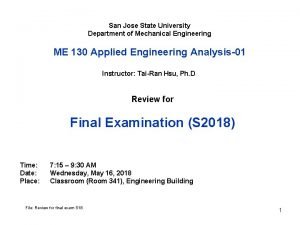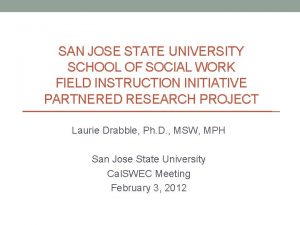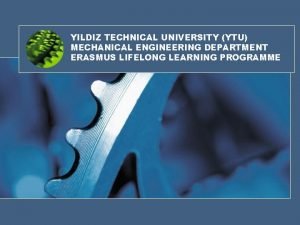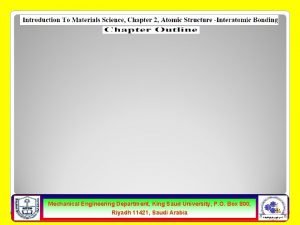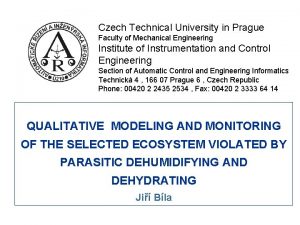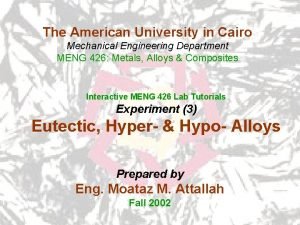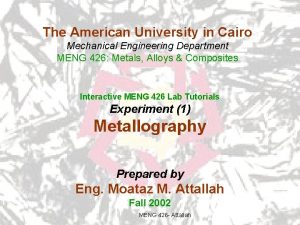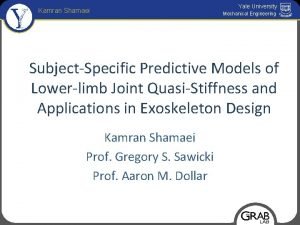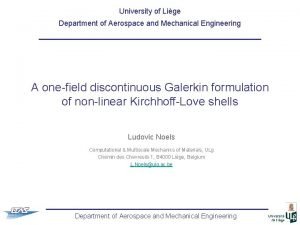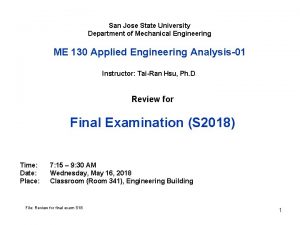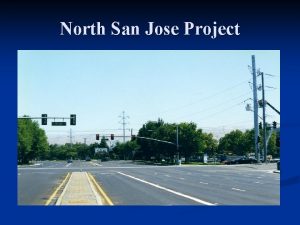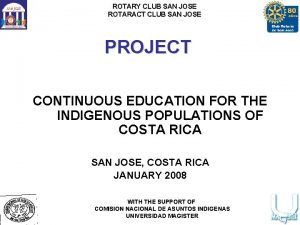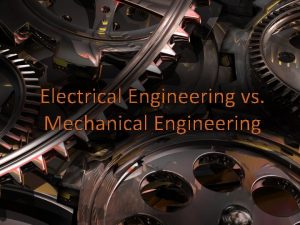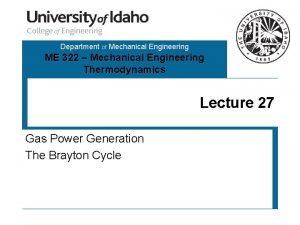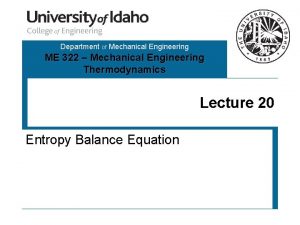San Jose State University Department of Mechanical Engineering









- Slides: 9

San Jose State University Department of Mechanical Engineering ME 130 Applied Engineering Analysis-01 Instructor: Tai-Ran Hsu, Ph. D. Review for Final Examination (S 2018) Time: Date: Place: 7: 15 – 9: 30 AM Wednesday, May 16, 2018 Classroom (Room 341), Engineering Building File: Review for final exam S 18 1

Format: Similar to that of Midterm Examination Materials coverage: 1) Printed lecture notes (S 2018) 2) Slides presented in the classroom 3) Class lectures (Plus condensed version) 4) Home work Approximate Scope of the Final Examination: Second Half of Chapter 3 (From Section 3. 5, p. 74) Chapters 4, 5, 6, 7, 8, 10 2

Chapter 4 Second Order Ordinary Differential Equations and Applications ● Typical form of 2 nd order homogeneous and non-homogeneous differential equations: Homogeneous equation: Non-homogeneous equation: ● Solution method with u(x) = emx, leading to 3 cases: a 2 – 4 b > 0, a 2 – 4 b < 0 and a 2 – 4 b = 0 for homogeneous equations ● Solution method with u(x) = uh(x) + up(x) for non-homogeneous equation, know how to derive uh(x) and up(x) ● Application of homogeneous equations for free-vibration analysis with and without damping – physical interpretation of analytical results? ● Consequences of mechanical vibrations to machines and devices ● Application of non-homogeneous equations forced vibration analysis: ● Resonant vibration – engineering consequences ● Near-resonant vibration – engineering consequences ● Modal analysis – why it is important and what are involved in the analysis? 3

Chapter 5 Introduction to Laplace Transform ● What is Laplace transform and why it is included in this course? ● Under what conditions can a function be transformed from a “variable domain” to a “parametric domain? ” ● Laplace transform of functions and derivatives ● What is inverse Laplace transform, and why? ● Inverse Laplace transform by “partial fraction” method ● Inverse Laplace transform by “convolution theorem” ● Using Laplace transform solving differential equations: ● Necessary conditions for using this technique ● General solution procedure ● The advantages of using Laplace transform in solving differential equations 4

Chapter 6 Overview of Fourier Series ● What is Fourier series and why? ● What are necessary conditions to have a Fouries series? ● Mathematical expressions of Fourier series ● Applications of Fourier series in engineering analyses ● What is “convergence” of Fourier series? ● How Fourier series converge for: ● continuous functions, and ● piece-wise continuous functions? ● Familiar with application of FS in the following case (motion, forces, ω or RPM to be avoided? ): 5

Chapter 7 Introduction to Partial Differential Equations What are partial differential equations? Under what situations one needs to use partial differential equations in ME analysis? Why partial differential equations are harder to solve than ODEs? What is the principle of “Separation of Variables? ” Why transverse vibration of “strings” is an important subject of ME analysis? Simple math models of transverse vibrations of strings The partial differential equation and solution for transverse vibration of strings (familiar with Example in Section 7. 6) Modal analysis of vibrating strings Why modal analysis? Natural frequencies of various modes of a string 6

Chapter 8 Matrices and Solution to Simultaneous Equations ● Why matrices- a component of linear algebra is a critical tool for modern engineering analysis? ● Matrices and determinants ● Different forms of matrices ● Arithmetic operations of matrices: +, -, and x ● Inverse of matrices ● Solution of large number of simultaneous equations using ● Inverse matrix method, and ● Gaussian elimination method ● Why large number of simultaneous equations? 7

Chapter 10 Introduction to Statistics ● What is statistics, and what is the scope of statistics? ● The histogram – what does it tell and how to establish it? ● The “mode, ” the “mean, ” “median, ” “variance, ” and “standard deviation” of statistical datasets, and their physical significances ● Method of determining: “mean, ” “median” and “standard deviation” ● The “normal distribution curves” – what do they represent? ● The “normal distribution function” – what is it? ● Why “normal distribution function” is fundamentally significant in statistical analysis? ● Why “statistical process control” (SPC) is a realistic and effective way of quality control of products in mass production? ● What tools do SPC provide? ● What are “control charts? ” What are the control charts presented in this course and how are they derived? ● How would engineers use these control charts in quality control in their production? 8

Graded Homework No. 6 on Chapters 7 and 8, and Homework No. 5 on Chapter 10 will be available for pick-up outside Room 117 between 9 AM to 12: 00 noon on Tuesday, May 15, 2018 Special Office Hours: 1: 00 to 3: 00 PM, Tuesday, May 15, 2018 GOOD LUCK 9
 San jose state university mechanical engineering
San jose state university mechanical engineering University of san francisco san jose campus
University of san francisco san jose campus San jose state msw
San jose state msw Ytuerasmus
Ytuerasmus Ksu mechanical engineering
Ksu mechanical engineering Czech technical university mechanical engineering
Czech technical university mechanical engineering American university mechanical engineering
American university mechanical engineering American university mechanical engineering
American university mechanical engineering Kamran shamaei
Kamran shamaei University of florida mechanical engineering
University of florida mechanical engineering
